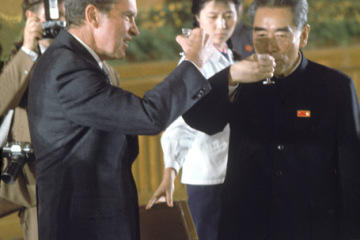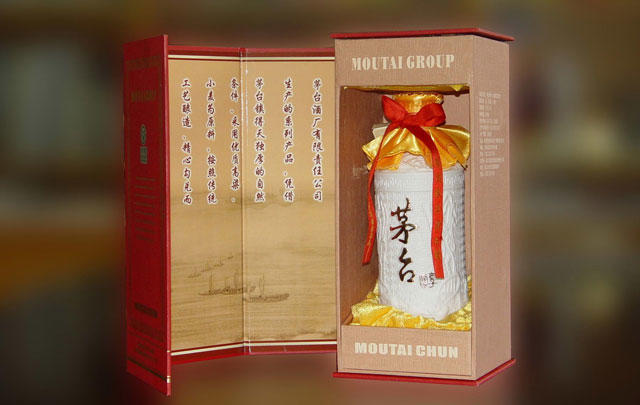Overview
Description
Product description
The product chosen for this market analysis is the Maotai Spirit manufactured by Kweichow Moutai of Guizhou Province, China. Established in 1951, Kweichow Moutai Winery has been able to grow steadily in the Chinese market through its luxurious brands of liquor drinks.
Specifically, Maotai (the sorghum-based liquor) has gained recognition as China’s national drink. About 55 percent of the drink is manufactured from sorghum and wheat, and for centuries, this practice has persisted in Maotai Town, Guizhou Province for centuries (Valkeinen par. 1).
In China, the alcoholic spirit has remained a significant part of the country’s tradition. It is recognized in several social events, including birthday celebrations, business entertainment, and state ceremonies. Spirit drinks have been used in China to show respect and happiness, and therefore China manufactures distilled spirit drinks in large volumes.
Name and naming strategy
Traditionally, the product has been known as Maotai, and it remains the most famous Chinese spirit drink. As a result, the product will retain its original name and continue to drive the brand in the global western market.
The spirit has a long history in China and is associated with the activities of the Red Army in 1935 and the Long March. The rebel commander, Zhou Enlai, later referred to Maotai as “China’s “national wine,” giving it an undeniable marketing edge over the other gullet-searing grain spirits, collectively known as baijiu, and tossed back at banquet tables across the nation” (Jacobs par. 1).
Position
It is not simple to find Maotai Spirit in the US market. Maotai Spirit is a luxury brand in China with a single bottle fetching over $200 (Jacobs par. 5). The product, therefore, will trade in the US market as a premium brand for high-end liquor consumers (Xin 3).
In the recent past, it has been noted that the price of Maotai has continued to rise steadily as the number of middle-class citizens continues to rise. On the contrary, the Chinese government has introduced measures to combat luxurious spending.
For instance, when the price rose by 20% in 2011, some lawmakers considered it appropriate to introduce a price ceiling on the ‘national spirit. The Spirit is rear and only brewed in a remote part of the city. The increasing costs of raw materials such as wheat, sorghum, water, and other grains have led to a steady rise in prices.
These conditions, coupled with affluence and rising consumerism in China, imply that the price of the product will not come down soon. Therefore, Maotai Spirit must be positioned as a luxurious, premium brand in the US market. The pricing strategy must support the expansion strategy and profitability noted in the recent past in China.
It is expected that Kweichow Moutai will use this opportunity as a countermeasure against the Chinese government that wants to encourage citizens to save more and spend less on luxurious products. As a result, the sales of luxurious spirit products have dropped in the domestic market (Li 1). The decision to venture into the western market would boost sales in the global alcohol industry.
Image
As previously noted, Maotai Spirit is regarded as the Chinese top liquor brand with a significant status symbol (Stein par. 1). Moreover, it is the Spirit of preference in many national functions. For instance, many global leaders such as “Richard Nixon, Kim Il-sung, Margaret Thatcher, and Ho Chi Minh, among others, have toasted Maotai Spirit in China during state functions” (Choi par. 5).
Based on the national and global recognition of the drink, the promotional campaign will portray the product as luxurious and appeal to many global consumers, including state officials. In addition, the product will be packaged colorfully to differentiate it from competitors.


Origin
This product exists in China. Under this project, it is expected that Maotai Spirit will be introduced into the US market and promoted as a global brand.
Data obtained from the Chine Alcohol Business Association have shown that the country’s spirit export has been poor. In fact, Maotai Spirit has a low record of export relative to other luxurious spirit brands such as Wuliangye manufactured in China.
Another significant factor for the decision to export Maotai Spirit is based on the action of the Chinese government. Li (1) has observed that the golden period for the growth of the Chinese spirit marker has long gone away since the year 2013. The government embarked on fighting corruption and targeted premium drinks. This situation led to a decline in demands for spirits for business purposes. In the year 2014, there was a notable decline in the Chinese spirit market.
The industry players have acknowledged this fact and have started to look for alternative international markets as turnovers continue to decline. The government also introduced policies to restrict the use of public funds on certain private affairs such as cars, overseas trips, and banquets, which received public approval. As a result, local authorities introduced different methods to curb the consumption of spirits in China.
In addition, the production of the spirits in China has been forecasted to decline in the future. It is therefore noted that the Chinese luxurious, premium spirit industry was most likely to be affected negatively by these government policies and political trends for many years to come.
Under such conditions, it was imperative for the high-end spirit brands to look for opportunities in the international markets to counter the rising challenges in the domestic market and develop new global expansion and marketing strategies for the success of the industry.
Situation Analysis
Market Classification
Maotai Spirit will be sold under different market segments. For instance, the product will have a primary market, secondary market, and terminal market.
Primary market
The Spirit manufacturer will deliver the liquor to wholesalers and agents for distribution across the US markets.
The company is most likely to establish a geographical network of distributors to resell the product in different states to other secondary markets or end-users.
These distributors will be essentially the company’s customers, and therefore, it would be prudent to train and support them and offer marketing materials and campaigns for Maotai Spirit.
Secondary market
The secondary market will provide opportunities for distributors to sell to retailers in different states of the US.
The secondary market will play a significant role in determining the right elements that consumers want and then implement them systematically to support the product.
Terminal market
The final liquor consumers will purchase Maotai Spirit in this market. Resellers will directly sell to consumers of the Spirit.
The ultimate goal of the distribution channel is to develop a market system that would eventually grow revenues and market shares in the US more rapidly. It is expected that potential consumers will receive the information they need about the drink through these distribution channels. By including the terminal market through retailers, it is believed that the product will have several successful marketing campaigns and programs to promote revenue growth and market share acquisition in the US market.
This approach is considered for entry into the US market because, in many cases, distributors, resellers, and retailers usually have readily available resources and strong relationships to promote and introduce Maotai Spirit to markets. The company will rely on these channels and relate to them as customers. Most importantly, it will strive to understand different needs and challenges in every channel of distribution and develop appropriate marketing programs to support revenue generation.
Target Audience
As the US economy continues to recover steadily, the premium liquor market is promising due to rising consumerism.
Premium spirits penetration in the US market is generally high. The past economic recession had affected consumption, but this situation is expected to change with increased employment and economic growth. Maotai Spirit can easily be introduced to the US market. However, the Chinese manufacturer must understand the market dynamics and respond fast to various prevailing conditions. Further, the company must observe price fluctuations and changes in consumers’ interests for imported products.
The major challenge would be trusting products from China because of the widespread proliferation of counterfeit, luxurious brands of spirits (Jacobs par. 6). These counterfeit Maotai Spirits are likely to end in the US market alongside genuine ones because the Chinese authority is unable to control them.
The target consumers will pay more for luxurious, quality Maotai Spirits, but not counterfeits. Three profiles of target consumers have been identified for this product in the US market.
World leaders
Given the historic nature of the drink and its association with prominent leaders from the US and other parts of the world, the marketing campaigns and promotions would target this segment of the market. The target consumers mainly relate with other individuals of similar statuses in society, are most likely to discuss international affairs, government issues, and business activities. They consume another premium, luxurious wines, and spirits, such as Champagne or Scotch.
Elites and Executives
Maotai Spirits will target young elites and business executives who only consume premium drinks and have gathered more experiences with a wide range of drinks. These consumers understand drinks; they are highly educated, much traveled, and adventurous. They want fine products with world-class recognition, great stories, and sophisticated production processes.
Successful Asian immigrants
Maotai shall be promoted to individuals who are considered as symbols of success in the US society. The drink has a great story in China and to US Chinese immigrants. Moutai has influenced Chinese culture for many centuries because of its great taste and unique production processes.
Chinese have always celebrated banquets and parties with Maotai. The drink is offered to highly successful, respected persons in society. It reflects a symbol of success and distinction in Chinese culture, and therefore, marketing promotions and campaigns must focus on this segment of consumers as people with high social status in America.
Maotai Spirit will, therefore, cater to diverse customers in the US market, particularly consumers aged over 35 years and willing to pay a premium for a luxurious, quality product with a long history in Chinese.
SWOT Analysis
Conclusion
Maotai Spirit, as a premium drink, will only survive in the US market if there are favorable distribution channels and strong promotions and campaigns supported with a fair pricing strategy.
Works Cited
Choi, Christy. Maotai Millions: Prices Rise for China’s National Spirit. 2011. Web.
Jacobs, Andrew. “Fake Liquors Flow as Demand Soars for China’s Fabled Sorghum Spirit.” The New York Times. 2011. Web.
Li, Feng. “The Challenges Moutai Faces When Developing Its UK Market.” American Journal of Industrial and Business Management 4.11 (2014): 1-5. Print.
Stein, Max. Maotai – A spirit worthy of the red carpet. 2013. Web.
Valkeinen, Jutta. Maotai – The Spirit of China. 2006. Web.
Xin, Livia. The top five luxury Chinese liquor brands. 2013. Web.